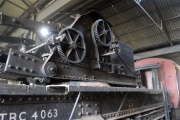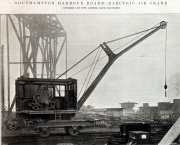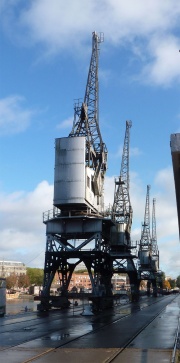Stothert and Pitt

























































































Stothert and Pitt of Bath, maker of cranes.
Formerly Stothert, Rayno and Pitt
c.1855 After Rayno retired the firm became Stothert and Pitt under John Lum Stothert and Robert Pitt
1869 Made a Titan crane for setting 27-ton blocks during construction of the Manora Point breakwater, Karachi ('Kurrachee'). Tested with 40-ton load in Bath, September 1869 [10]
1876 Supplied a blocksetting crane to Colombo Harbour Works, Ceylon for breakwater works. Stothert and Pitt; 17/30-ton non rotative, sidesetter. Supplied with two styles of jib which probably explains the two capacities noted. 1875-1884 works utilized 30 -32T sloping bond block; 4212’; completed 1885. Worked in conjunction with the 1876 Taylor blocksetter. Photo - p182, 'Civil Engineering, Photographic History', M.Chrimes. [11]
1883 The health of the 2 partners worsened; the company was incorporated as a Limited Company with Mr Stothert as chairman; he remained in this position until his death.
1884 Description and engraving of a 45 ton block setting crane at the Albert Edward Dock at Coble Dean, Newcastle.[12]
1886 Description and engraving of a 20 ton block setting crane at Mandavee, India [13]
1891 15-ton locomotive steam crane for steelworks. 'The design embodies a powerful crane and also a complete locomotive, able not only to propel the whole machine nut also to do a very considerable amount of shunting Work. This is effected by fitting up the under carnage with a set of independent travelling engines entirely disconnected from the crane engines proper, an arrangement adopted many years ago by Messrs. Stothert and Pitt for some heavy cranes made by them for the late Landore-Siemens Steel Company.' See illustration [14]
1892 Description of 'ladder dredger' made for the Great Western Railway and used for cleansing the Kennet and Avon Canal system. It was specially designed to meet the requirements of canal dredging, the principal difficulties to be overcome being the exceedingly small beam requisite for passing narrow locks, and the low limit of headway given by existing bridges. The was 60ft. long, with a beam of 7 ft., but increased to 9ft. 6 in. by means of detachable flotation pontoons. The engines had two cylinders 7 in. diameter by 10 in. stroke. Steam is supplied by a vertical boiler 3 ft. 6 in. in diameter by 7ft. 6 in. high. The engines drove the buckets by a belt furnished with a tightening pulley. The dredger was designed by its builders under the instructions of William Dean, locomotive superintendent of the GWR. It was worked under the superintendence of C. F . Hart, the engineer to the GWR's Kennet and Avon Canal system, 'and we understand that it has given every satisfaction during the two or three years it has been at work.] [15]
1897 Description and illustration of 40-ton block setting crane made for S. Pearson and Son for use in the construction of the harbour works at Vera Cruz, in Mexico. [16]
1899 Photos of a Titan and a Goliath crane supplied for the Otaru harbour works in Japan [17]
1902 Public company. The company was registered on 2 July, to acquire a business of engineers, manufacturers of harbour and dock plant and electric cranes. [18]
1905 70-ton overhead travelling crane for Natal harbour blockwork. 135 ft 8" span. The steel gantry was made by Joseph Westwood and Co of Millwall. The motors and control gear were supplied by Bruce, Peebles and Co.[19]
1911 Steam crane for Singapore made for Topham, Jones and Railton. [20]
1914 Built their largest Titan crane to date at Victoria Yard. It was built to the order of Messrs. Topham, Jones, and Railton for block setting at the breakwater at Fishguard Harbour. It was described as the largest travelling crane of its type ever built in this country. The crane was designed for loads of 40 tons at a maximum radius 125 ft. [21]
1914 Manufacturers of cranes and harbour plant. Specialities: giant cranes and titans for harbour construction, electric cranes for docks, large cranes for railways, capstans and hauling gear, concrete machines. Employees 900. [22]
1918 1918 3no. 36 ton breakdown cranes built for the Ministry of Munitions for use by the British Army Railway Operating Department on the Nord Railway in France and Belgium. They were out of gauge for use on British main lines.ne survived on the SNCB until about 2000. It had to have its jib modified.One probably never left England and was sold to the Prince of Wales Dry Dock Co., Port Talbot.[23]
1921 Mr Wilson S. Carr represented the company on the South-East Coast.[24]
1921 C. M. Toplis was chief engineer; the company supplied Toplis cranes for ships[25]
1922 Supplied six 25-ton capacity cranes to Fougerolle Frères of Paris for port construction in Morocco. These were steam-powered rail-mounted cranes weighing 95 tons, with a 37 ft jib.[26]
1924 Mr Claude M. Toplis who was for the past fourteen years chief engineer resigned. Major E. G. Fiegehen was the remaining partner.[27]
1926 Entrusted by the Calcutta Port Commissioners with an order for twenty-four 2-ton level luffing electric jib cranes for the equipment of the quays at the King George Dock in Calcutta. Eighteen cranes are of the semi-portal type - twelve for the import shed and six for the export shed and the remaining six are of the full portal type and intended for the import shed.[28]
1930 Long-reach block setting crane for South African Railways & Harbour Dept, Table Bay. Max radius of load 105 ft. [29]
1933 Started to produce multi-bucket excavators. These were powered by diesel engines or electric motors. An example was displayed at the 1933 Public Works Exhibition [30]
1937 Engineers. [31]
1940 Advert. Screw displacement pumps. [32]
1945 Advert. Designers and makers of electric, steam and diesel cranes, concrete mixers, road making and quarry plant. excavators, ship's windlasses, winches and capstans etc. [33]
1949 Two cranes made by Stothert and Pitt were installed on Melbourne's Station Pier at the seaward end. Although decommissioned in 1975, they remained in place until 1996.
1960 Multi-bucket excavators. [34]
1960 Advert. Electric and diesel-electric cranes, concrete mixers, vibrating rollers, road making and quarry plant, multi-bucket excavators etc. [35]
1961 Manufacturers and exporters of cranes; concrete mixers, truck mixers, vibrating rollers, batching plant and quarry plant; rotary and screw displacement pumps, centrifugal and marine pumps; windlasses, winches and capstans. Also manufacture multi-bucket excavators. 2,200 employees. [36]
1967 Obtained a licence to produce bucket wheel excavators designed by ERMI of Paris.[37]
1968 Contract for twelve cargo cranes to Mersey Docks and Harbour Board. [38]
1986 Robert Maxwell's Pergamon Holdings injected £4million into the company in exchange for 77 percent of the equity[39]
1989 The crane division was sold to NEI[40]
2015 One of the Melbourne Station Pier cranes, was reinstalled as part of the heritage interpretation scheme for the pier.[41]
- Goliath cranes, sometimes called portal cranes, are similar to overhead travelling cranes, but instead of running on rails at high level, or on a free standing gantry structure, they run on rails on the floor. One of the advantages of a goliath crane is that the absence of support gantry rails can save money.
The Fairbairn Steam Crane at Bristol
Built in 1878 by Stothert and Pitt to William Fairbairn's 1850 patent.
The oldest surviving exhibit of its type in Britain and a scheduled ancient monument.
The crane's strength lay in its jib, which was made of wrought-iron plates riveted together to make an immensely strong tubular-section girder. It could lift up to 35 tons (35.56 tonnes) and was meant to supplement the lifting ability of the Docks' other 17 cranes.
The crane has now been restored to full working order and is the responsibility of Bristol's 'M Shed'. [42]
See Also
Sources of Information
- ↑ Engineering 1892/10/14
- ↑ Mr. C. Capewell.
- ↑ Mr. C. Capewell.
- ↑ Mr. C. Capewell.
- ↑ Mr. C. Capewell.
- ↑ Mr. C. Capewell.
- ↑ Mr. C. Capewell.
- ↑ Mr. C. Capewell.
- ↑ Mr. C. Capewell.
- ↑ 'Engineering' 27th September 1869
- ↑ Chris Capewell
- ↑ Engineering 1884/09/19
- ↑ Engineering 1886/04/16
- ↑ Engineering 1891/09/25
- ↑ Engineering 1892/10/14
- ↑ Engineering 1897/05/14
- ↑ Engineering 1899/12/15
- ↑ The Stock Exchange Year Book 1908
- ↑ [1] The Engineer, 10 March 1905
- ↑ The Engineer 1911/12/15 p627
- ↑ Bath Chronicle and Weekly Gazette, 16 May 1914
- ↑ 1914 Whitakers Red Book
- ↑ C. Capewell
- ↑ The Engineer 1920/12/24
- ↑ The Engineer 1921/05/13
- ↑ The Engineer 1922/08/18
- ↑ The Engineer 1924/06/20
- ↑ The Engineer 1926/07/09
- ↑ The Engineer 1930/03/21
- ↑ [2] The Engineer, 17 Nov 1933, pp.501-2
- ↑ 1937 The Aeroplane Directory of the Aviation and Allied Industries
- ↑ Mechanical World Year Book 1940. Published by Emmott and Co of Manchester. Advert p204
- ↑ Mechanical World Year Book 1945. Published by Emmott and Co of Manchester. Advert p242
- ↑ Mining Year Book 1960. Published by Walter E. Skinner. Advert p741
- ↑ Mechanical World Year Book 1960. Published by Emmott and Co of Manchester. Advert p242
- ↑ 1961 Dun and Bradstreet KBE
- ↑ 'Stothert & Pitt - Cranemakers to the World' by Ken Andrews and Stuart Burroughs, Tempus Publishing, 2003 & 2011, p.77
- ↑ The Engineer 1968/02/09 1968 p253
- ↑ The Times, October 17, 1986
- ↑ The Times, March 03, 1989
- ↑ Lovell Chen News
- ↑ http://mshed.org/visiting/on-the-dockside/the-fairbairn-steam-crane/

